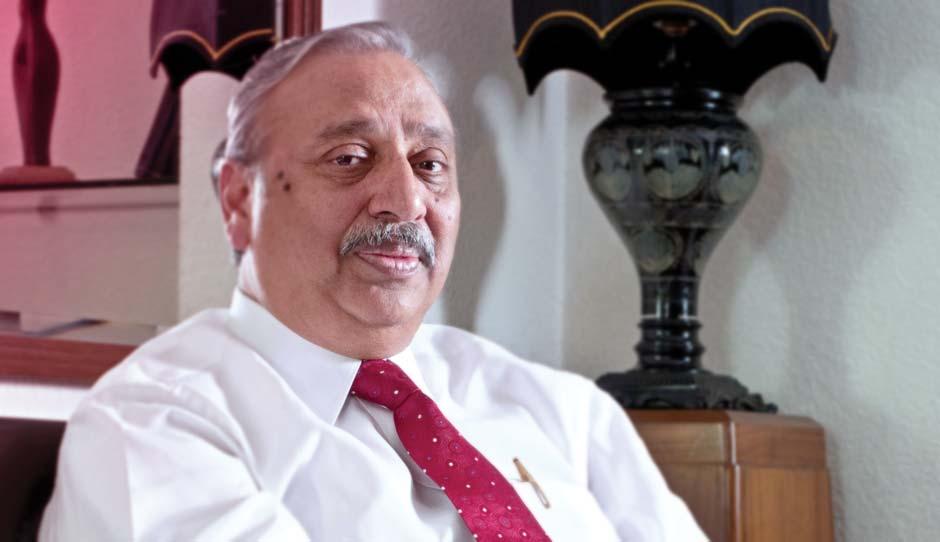Why Kent RO's Founder Claims He is Unambitious
- BY Shreyasi Singh
 In
In  21484
21484 0
0

Mahesh Gupta has created a steady stream of business from the most basic of elements, water. Kent RO Systems, his health products company, revolutionised water purification technology by pioneering the reverse osmosis (RO) technique in India. Today, Gupta has a 250-crore turnover pool to play with and definite 1,000 crore aspirations. But, it’s the huge challenge of bringing clean drinking water to every Indian that gets the scientist in him really excited.
“I’m not a very, very ambitious person,” is how Mahesh Gupta, founder and chairman of Kent RO Systems, begins his story about his Noida-based healthcare products company. It isn’t a claim that’s instantly believable. It certainly doesn’t sit easy on a man who plans to take his product, a revolutionary water purifying system, to every Indian home in the future. Everyone should have the right to clean water, he stresses. But that’s the scientist in him talking—the one that sensed the urgency to build a new kind of water purifier just because the ones sitting in the market didn’t seem to be doing the right kind of cleaning.
The entrepreneur in him, he insists, is far less overreaching. Gupta confesses that his 12-year-old firm, which picked up a tidy revenue of over 250 crore last fiscal, could possibly have grown much faster had he gone down the private equity and venture capital route. “But I am a first generation entrepreneur. My financial risk-taking capacity is very poor. I can’t borrow money. It makes me very uncomfortable,” adds the 56-year-old.
Well, it isn’t only money Gupta has problems borrowing. Even with technology, he’d much rather just have his own than “make do” with the options on offer. When his teenaged children, Varun and Surbhi, fell prey to jaundice in 1998, Gupta was forced to look for water purifiers to install at his south Delhi home. He set out to search the market. The stuff sitting on the shelves left him largely unimpressed.
So Gupta, an alumnus of IIT Kanpur, decided to noodle on the technology and flesh out his own ideas. It helped that he was by then running SS Engineering, a petroleum products company, his first entrepreneurial venture after leaving his Indian Oil job. “It’s my nature to work on new things. Also, I knew how to source components because of my company.”
Five months and almost 1 lakh later, Gupta came up with a purifying system, unique because it worked on the reverse osmosis (RO) system, unlike the chemical based and ultraviolet light purifiers such as Eureka Forbes’ ubiquitous Aquaguard.
The product was ahead of its time but Gupta sensed in it a nugget idea that could play into big market trends—in short, a thriving business. He was definitely barking up the right tree. In a country, where approximately 80 per cent of diseases are caused by water-borne microorganisms and an estimated 80 per cent of urban dwellers do not even purify tap water, the market for water purifiers was bound to be huge. Gupta pushed his product on the market ramp, and switched on the lights of a company that has sold nearly a million units since then and created a brisk-flowing consumer goods brand.
The Clean Brand
Today, as pioneers of the mineral RO technology, Kent has captured more than 30 per cent of the water purifier market—a range somewhere between 1,000 to 2,000 crore—in India, says KPMG Advisory’s Anand Ramanathan. Yet, the maths is meaningless till you comprehend the science involved, asserts Gupta.
In terms of technology, the Kent model stood out right from when it took shape in Gupta’s shop floor. Market leading purifiers then, and even now, mainly work on the ultraviolet (UV) light principle. Essentially, in these purifiers, water goes through ultraviolet light which attacks the bacteria and kills them, giving users bacteria-free water. As a concerned parent, Gupta knew this wasn’t nearly enough. With greater industrial activity, the ground water had become contaminated with impurities that dissolve in water such as arsenic, rust, pesticides and fluorides, he explains. “Take salt, for example. Or sugar. Once dissolved into water, you can’t see them. The UV light method can’t rid the water of such dissolved substances. I wanted to make a purifier that would remove these.”
In fact, according to the process patent finally awarded to them in 2006, Kent models such as Grand, Ultra, Elite and Excel, actually have a robust, three-tier purification system. Water is first passed through a sediment filter, then a carbon filter and ultimately UV light. The sweet spot of Gupta’s system is, however, its ability to contain the good minerals inherent in water even while flushing out the bad elements. “That’s a problem with other RO purifiers, the minerals get washed away.”
Having hired Isobar India as its digital agency, Kent RO Systems is now ensuring that it leaves no stone unturned in engaging with its online consumers, be it through its Youtube Channel, facebook page or twitter handle.
Yet, Kent is not just an improved technology to clean water. It’s also a smart product, says Gupta. He’s meshed into his product design elements of common sense and practicality.
Till his machines came about, most other purifiers came as under-the-counter or over-the-counter appliances like the models popular in western countries. Gupta thought these models were unsuitable for Indian kitchens where oil and spices were a major part of the cooking routine. Most Indian kitchen counters are wiped several times a day to remove the stickiness and stains caused by the extensive cooking.
Gupta changed all that, installing his purifiers on walls. “It was the first RO to ever be put up on a wall,” he claims proudly. Yet, instead of winning brownie points for such innovations, Kent struggled to get the attention of customers. “Competition from other companies hasn’t been as much of an issue as resistance from customers to change over to a new technology,” says R.S. Rao, general manager at Kent, and one of the company’s first employees.
I am a first generation entrepreneur. My financial risk-taking capacity is very poor. I can’t borrow money. It makes me very uncomfortable." - Mahesh Gupta
First of all, Kent’s purifiers were prohibitively priced at 21,500 per unit. Adjusted for inflation, that was like a little fortune in the late 1990s. To make it worse, rival Eurkea Forbes, which dominated the water purifier market, was selling its Aquaguard at around 4,000. Unless the customer was absolutely convinced, and was actually shown that the water was pure, sales wouldn’t flow in. So, Kent RO’s team of five sales executives held demonstrations in customer’s homes across upmarket neighbourhoods in Delhi. Gupta developed a special kit for the purpose—a TDS Meter to measure the total dissolved solids, and an Electrolyser to show how poor the quality of water was.
Still, sales in the first few years were depressing. Sales executives would struggle to meet even the modest target of five units a month. “People told me I was mad, that I’d be out of business soon, or worse that I was cheating people,” recalls Gupta, who set up his first manufacturing unit in Noida in 2000. “But I didn’t have a social product. I couldn’t make it for less than this.” Rao honestly wonders how Gupta found the positivity to stay the course. “It had to be pure determination and conviction. He couldn’t have withstood the customer’s resistance otherwise.”
It wasn’t easy, Gupta says. “I thought of winding Kent up several times in the first couple of years. My petroleum conservation business was doing very well but I’d be spending more time on Kent. Somehow, I just knew this business would do very well.”
In 2005, Mahesh Gupta realised his technology might be ahead of the curve but his marketing strategy was outdated, at worst, and misplaced, at best.
Writing His Own Script
It took them eight years, or until 2006, to breach the 25-crore mark. But, in the past five years the company has multiplied 10 times over. “We sold 130,000 units in 2009 and jumped to 180,000 units in 2010. We’ve been growing 40 to 50 per cent every year now,” says Gupta excitedly.
This brisk pace is instantly evident. In April 2011, 23,000 Kent units were sold across their portfolio of nearly 25 products, which now includes other innovative products like ozone-based air and vegetable purifiers, water boosters and water softeners. Within a couple of months, Gupta says, his monthly sales will be leaving the 30,000-mark resolutely behind.
Two reasons have scripted this growth including, Gupta admits, a little bit of finally being at the right place at the right time. According to India Water Purifier Market Outlook 2014, a report by global marketing research and consulting company TechSci Research, the Indian water purifier industry has grown exponentially at a 22 per cent CAGR in the past few years. With increasing number of people becoming conscious of the risks of drinking contaminated water, the demand for water purifiers was rising rapidly, the report said. This, in turn, has pushed up sales, especially since 2008.
Right now, it almost seems like an unending opportunity environment with an estimated 80 per cent of urban dwellers having no access to water purifiers yet, says KPMG’s Anand Ramanathan. “Only about 10 per cent of urban India and less than 1 per cent of rural India has been penetrated so far,” adds Ramanathan.
Gupta put Kent within touching distance of those numbers with one stroke of marketing genius. In 2005, he realised his technology might be ahead of the curve but his marketing strategy was definitely outdated, at worst, and misplaced, at best. He’d been hoping to transfer the skills he’d picked up while establishing SS Engineering, his petroleum products company, to market Kent as well. “Because my experience was in industrial product marketing, I marketed Kent RO like an industrial product,” he laughs.
He didn’t want to tread the direct marketing path which had made Eureka Forbes the household name that it is today. “I always look ahead, never sideways or backwards to see what the competition is doing. I don’t want to learn from their strategy.”
Gupta knew that if he wanted his product to fly, he had to create a brand that consumers would trust and instantly connect with. For this he needed a star, someone who was a parent, to tout and build faith in the product. In 2005, he convinced Hema Malini, a mother of two daughters, to essay that role. She tested the product out in her Mumbai home for a few months before agreeing.
 It isn’t often that a small company has the gumption or ability to create high-impact advertising campaigns, and get big names to come on board. Kent changed the game when it got Hema Malini to endorse their brand in 2005.
It isn’t often that a small company has the gumption or ability to create high-impact advertising campaigns, and get big names to come on board. Kent changed the game when it got Hema Malini to endorse their brand in 2005. Because Gupta didn’t have money to make television campaigns with Malini in the first year, they worked on a print launch, moving to the now-famous television advertisement where the actress, wearing outfits in various shades of icy, cool blue, assures you that Kent purifiers give you the “purest water in the world”.
In the following years, Malini’s daughters, Esha and Ahana, were added into this “perfect family” campaign.
Gupta today spends a conservative 12 to 13 per cent of their turnover in branding. “I never liked campaigns designed by my agencies. I made my own campaigns, wrote my own scripts, told the agency to do it like this. We stick to simple statements. I am not selling chocolate. I just want to put it out there, it’s a necessity product.”
“The way he branded was the second innovative thing he did. He invested in creating a brand early on and did it so successfully,” says Chetas Desai, managing director at Ambit Corporate Finance, a leading investment bank, and somebody who’s watched Kent’s growth over the past few years.
I want to overthrow the plastics industry. That’s my vision. I’m going to do this in the next 2-3 years." - Mahesh Gupta
Gupta also established a great distribution network, putting Kent machines at large retail outlets like Big Bazaar and white goods stores across the country. Even here, Desai adds, he stayed away from peddling aggressive discount deals and spurious offers. “He wants the consumer to buy, not the dealer to sell. He believes in creating a business proposition to see why somebody should buy his products.”
Gupta waves off such praise in his characteristic, matter-of-fact tone. “Honestly, I don’t know how to market. I was just driven by the situation, by common sense. Nobody needs Einstein’s calculations to do these things.”
Cost Concern
Of course, now, he hopes to piggybank on these strengths to scale up. But, it’s unlikely to be an easy ride with competition heating up. Apart from market giant Eureka Forbes, global majors such as Philips and Hindustan Unilever are also looking to increase their share of the pie.
And, a bulk of consumers will enter the purifier market with the hugely economical chemical purifiers, a segment companies like Eureka Forbes and Hindustan Unilever with their brands Aquasure and Pureit—which don’t run on electricity and don’t demand continuous water supply—are tapping aggressively, Ramanathan says. Not surprisingly, these brands have managed a growth rate of 100 per cent per annum.
Moreover, UV purifiers continue to dominate the market with nearly two-thirds of all sales. Here again, Eureka Forbes’ Aquaguard leads resolutely with a nearly 70 per cent market share. Philips’ Intelligent Water Purifier and Kent’s own UV purifier have much smaller shares. RO purifiers aren’t preferred options mainly because they’re still very expensive. A basic model at Kent, for example, costs 14,500 per unit.
It isn’t a challenge Gupta shies away from discussing. “I knew when I began that I was starting with a disadvantage because I wasn’t catering to the bottom of the pyramid segment which HUL is doing. They are selling millions of units,” he says. “Our biggest challenge today isn’t technology. It is to provide economical solutions. Everybody deserves clean water but they can’t all afford 14,500 machines.”
And for that, he’s set himself a hard target—purifiers that cost less than 10,000. The economies of scale has continuously helped him to contain and prune his prices over the last decade.
The goal of a “four digit” pricing might take another two years, by when he should be selling
 Mahesh Gupta isn’t alone in his quest. Gupta’s 28-year-old-son, Varun, recently joined him after completing his MBA from the Columbia Business School in the United States.
Mahesh Gupta isn’t alone in his quest. Gupta’s 28-year-old-son, Varun, recently joined him after completing his MBA from the Columbia Business School in the United States. 500,000 units a year, the optimist believes. He’s readying up new manufacturing units in Greater Noida and Noida to hike up production. “You can’t imagine what this can grow to. People will eventually upgrade to RO machines. People begin by buying a scooter. But, they upgrade to a full transport, a car, don’t they? That’s what will happen here as well.”
Yet, there are other daunting tasks ahead. Kent has received a lot of flak for indifferent customer service. KPMG’s Ramanathan warns, “The company should significantly concentrate on these issues before expanding.” Gupta says it does “pain” him to have his servicing standards questioned despite having a wide network—17 centres staffed by 150 people in just the national capital region to handle customer complaints. “Of course, it still continues to be a big challenge,” he admits.
Varun Gupta, Gupta’s 28-year-old son who’s recently joined the company after an MBA from Columbia Business School, says many of these perceptions arise from what continues to be their biggest obstacle—customer education. His father concurs. People don’t realise our water filters are actually a chemical plant in a small appliance, Gupta senior says. And, despite training their distributors and dealers to prepare customers for the fact that sophisticated RO purifiers are high-maintenance, Gupta admits disappointments come in because customers have been misled in the rush to clock in a sale. “I tell our distributors that if you have 100 satisfied customers, they’ll bring you another 100. But if you have 100 unhappy customers, they will take away 1,000 potential customers from you by negative word-of-mouth.”
Thinking Big
For now, what Gupta really wants to do is is filter out the “real problems”. “I feel miserable when I see a street vendor selling water to people. What’s the quality of water he’s giving? But for a person standing at a bus stop in this heat, there is not much choice,” laments Gupta. It’s an issue that’s been constantly gnawing at him. Over the next few years, he wants his company to set up “retail kiosks” where the people can get a glass of clean, chilled water at around a rupee or so.
Gupta says India used to be a country which loved its glass of water. But things have changed with clean water becoming more and more of an oxymoron.
As the taps for clean water ran dry, people turned to packaged water and soft drinks. The situation, asserts Gupta, is unsustainable at the basic level, especially since it’s dramatically grown the plastic industry. “I want to overthrow the plastics industry. That’s my vision. I’m going to do this in the next 2-3 years,” he says. Little wonder then that we found Gupta’s earlier claims of “slow ambition” doubtful. If these plans aren’t a tidal wave of force, we don’t know what is.





























Add new comment